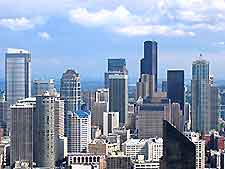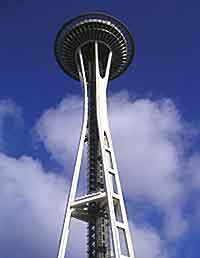Seattle History Facts and Timeline
(Seattle, Washington - WA, USA)

The largest city in America's Pacific Northwest, Seattle is famous as a trendsetter and a free spirit, leading the way in everything from urban environmentalism to alternative music.
With its rich and rowdy heritage stemming from the Klondike Gold Rush (1897 to 1899) and the timber industry, Seattle has shaped its history on its own terms. It is still regarded as one of America's most energetic and independent cities - a frontier town of sorts for the modern era, except the pioneers in Pioneer Square are now tech experts instead of hopeful gold prospectors.
Pacific Northwest Expeditions
Like most of the towns in America's Pacific Northwest region, Seattle was born out of an expedition. George Vancouver, the famous British explorer and captain, was the first European to arrive when he sailed around the many bays and inlets of Puget Sound in 1792. But it wasn't until nearly six decades later that two separate, smaller, expeditions known as the Collins Party and the Denny Party set up camp in 1851.
The two groups competed for dominance of Elliot Bay as rival camps, but in the end the Denny camp won out, establishing the village of Duwamps, which was situated where downtown Pioneer Square sits today. By the end of the 1850s, the town had been laid out and was beginning to grow. It was renamed Seattle in honor of the local Native American Chief Seattle of the Suquamish tribe.
A Resource Boom
Like many frontier towns in America, Seattle has a history that has always been tied to boom and bust cycles. The first boom came from timber, courtesy of the vast forests of old-growth pine and cedar that covered the region. The original Skid Row, today's Yesler Way, was where the huge logs were rolled downhill into the bay.
The Great Seattle Fire of 1889 destroyed most of the Central Business District, but this blessing in disguise resulted in a much grander city being built in its wake. The second boom came from the Klondike Gold Rush at the end of the 1800s. This was a much greater economic explosion, lasting for more than two decades and helping to establish much of the city's wealthy foundations and original businesses.

A City is Born
The money that flowed in from gold fortunes was used to build the downtown core around Pioneer Square. Labor was supplied by waves of migrants, such as the Chinese, who by the beginning of the 20th century made up some four percent of Seattle's population. This led to tensions that eventually called for martial law. Their ethnic district is still around today in the form of Chinatown. Theaters such as the Paramount provided cultural entertainment, and hotels like the Seattle Hotel gave intrepid visitors a fancy place to stay.
Post-War History
After the gold rush faded, Seattle went into dormant mode. It wasn't until WWII that the economy ramped up again, thanks to Boeing and the demand for aircraft. Boeing helped push Seattle back into the history pages and it remains one of the city's main employers. The city even hosted the World Fair in 1962, while other big companies soon arrived, most notably Microsoft, which set up its headquarters here in 1979.
Today, Seattle is one of America's top cities in terms of economic strength and quality of life. Its music scene is always at the cutting edge, while environmental initiatives have helped the city emerge as one of America's greenest. With its mix of natural beauty and creativity, the city looks set to remain strong and attractive for technology firms and artistically minded residents.
 The largest city in America's Pacific Northwest, Seattle is famous as a trendsetter and a free spirit, leading the way in everything from urban environmentalism to alternative music.
The largest city in America's Pacific Northwest, Seattle is famous as a trendsetter and a free spirit, leading the way in everything from urban environmentalism to alternative music.